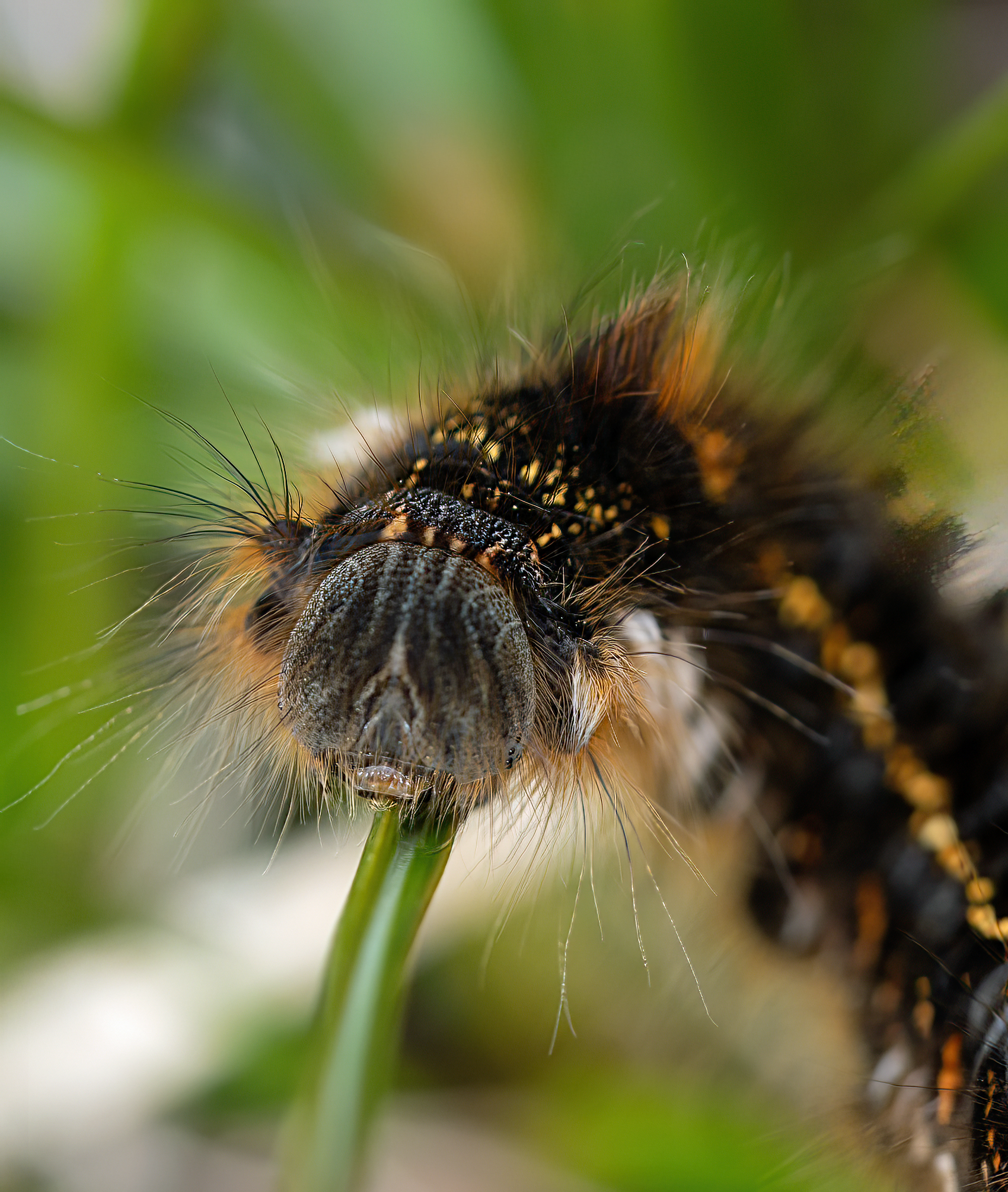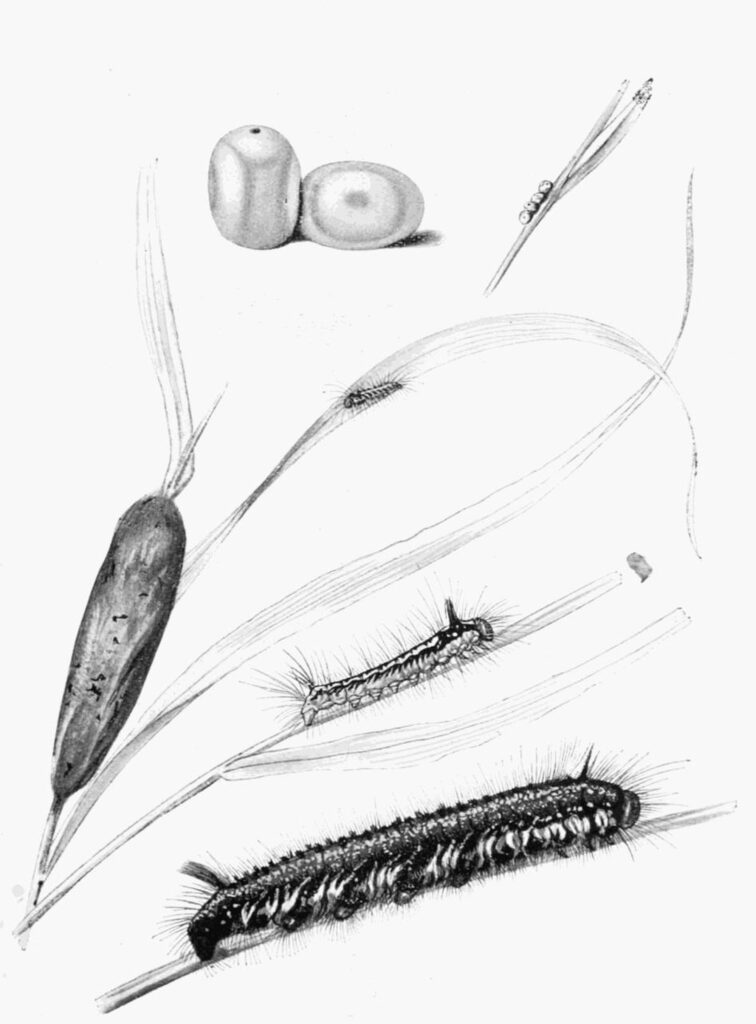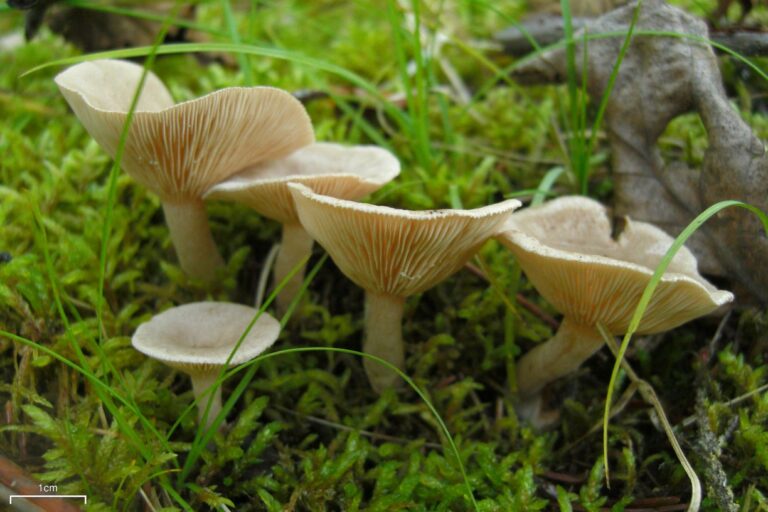By Susan Kirkup

Image © Dean MacAskill.

The Drinker, is a moth of the family Lasiocampidae, the Eggar and Lappet moths. This family has approx. 1000 species which occur throughout the world. Of that 1000 only 10 are natural residents in the UK.
These are chunky medium to large sized moths with deep rounded warm brown or yellowish wings, which have markings of a small central spot or two cross-lines on the forewing.
The species’ common and Latin names are derived from the larva’s supposed habit of drinking dew drops from grasses as it feeds. They are covered in dense hairs for protection against bird predation, but the cuckoo appears to have perfected the skill of removing the outer hairs, and many larva provide a hearty meal for them in the Spring. They are one of the most frequently sighted caterpillars in the British Isles as can be seen from the NBN Atlas distribution map below. There is a distinct east – west distribution in Scotland. Here in the North they have been seen from as late as the end of September/beginning of October, and as early as mid-February, according to current records.
Life Cycle
Illustration showing the various drinker moth life cycle stages.
The egg
Life begins as an egg. The adult female moth lays her eggs in small batches or clusters on the stems of reeds and grasses during July and August after mating. The eggs hatch within approx. ten days and the tiny larva emerge already with distinctive markings.
The Larva
The young larva will feed and develop passing through 4-5 stages called instars. At each instar they will shed their skin, markings will change and distinct features such as the front and rear hair tufts will develop



The stunningly marked larvae that we are used to spotting are usually in the final stages of development and up to 7cm in length. They have brown hairy tufts along the length of the dark grey/blue abdomen, and a line of distinctive white tufts on either side of the body. There are longer tufts of hair near the top of the head and at the rear end. The abdominal speckled markings look as if gold dust has been sprinkled on them.
The larvae feed mainly at night but can be found resting during the day on grass stems, reeds and other food plants. They over winter, hibernating and feeding in milder weather. In the Spring and early summer they are very active, feeding up for a period before pupating.


The Pupa
The fully grown larva spins a robust buff-coloured cocoon amongst grasses or reed stems, often incorporating some of its hair in the process. This usually has a papery appearance with the pupal case forming inside. The pupal stage lasts for approx. one month and it is during this stage in the life cycle that the most dramatic transformation takes place.
Within the pupal case, most of the larval body breaks down via a process called histolysis. Special transformative cells, which remained hidden and inert during the larval stage, now become important in the body’s reconstruction. These cells, called histoblasts, initiate biochemical processes which transform the deconstructed larva into a moth. The process is called histogenesis, coming from the Latin words histo, meaning tissue, and genesis, meaning origin or beginning.
Once the metamorphosis within the pupal case is completed, the moth may remain at rest until a particular trigger signals the time to emerge. This could be a change in light or temperature or a chemical or hormonal trigger. Usually the top part of the cocoon is thinner than the rest enabling the emerging moth to break through the surface
The Adult moth
Adult moths emerge and for the first few hours they need to pump hemolymph (invertebrates equivalent to blood) into their wings to expand them. Once the wings are dried and expanded the adult moths can fly in search of a mate and begin the process all over again.
Adult moths have a wingspan of 41-70cm with females being slightly larger
Adult males have broadly feathered antennae which can detect the scent of an unmated female several hundred metres away. The male is usually warm reddish brown with yellowish patches, the female varies from deep yellow to very pale buff, whitish or reddish brown like the male.
When to look
Adult moths are nocturnal, fly during July and August, usually at night but can be disturbed from their resting places during the day.
Larvae appear from August until the following June. They feed mostly at night but can be spotted often during the day, basking in the sun on grass stems or reeds. They are most often spotted here in the North in late summer to early autumn before hibernating and then again in early Spring.
Where to look
The habitat of this species is mostly tall damp grassland, marshes ,boggy areas, heathland, scrub, ditches, damp open woodland and also in gardens, and sometimes drier areas. I have seen them on heather, alder and birch trees, but most often in ditches and in the wild undisturbed areas of the garden. When the larva are ready to pupate they can often be seen crawling along the ground in search of a preferred site.
Larval Food Plants
A wide range of coarse grasses and reeds including Cock’s-foot (Dactylis glomeratus), couches, Common Reed (Phragmites australis), Reed Canary-grass (Phalaris arundinacea) and Wood Small-reed (Calamagrostis epigejos). The adult moths do not feed.
This is a very charismatic species and although common, it is a joy to behold, both in larval and adult form. It was one of the very first moths I caught in my garden trap when I began mothing a number of years ago and I was captivated by it. Since then I have also been spellbound by the sheer beauty and resilience of the larvae. Always a highlight for me to spot my first Drinker caterpillar, it is the herald of a new wildlife watching year.

Unless otherwise stated, all images © Susan Kirkup.
Thank you to Dean MacAskill for kindly allowing the use of his images.
References:
Caterpillars of the British Isles: J. Porter.
Field Guide to Moths of Great Britain and Ireland: Waring, Townsend and Levington.
Field guide to Caterpillars of Great Britain and Ireland Henwood: Sterling and Levington.
British and Irish Moths: A Photographic Guide: C. Manley.
NBN Atlas.
UK Moths
Butterfly Conservation











